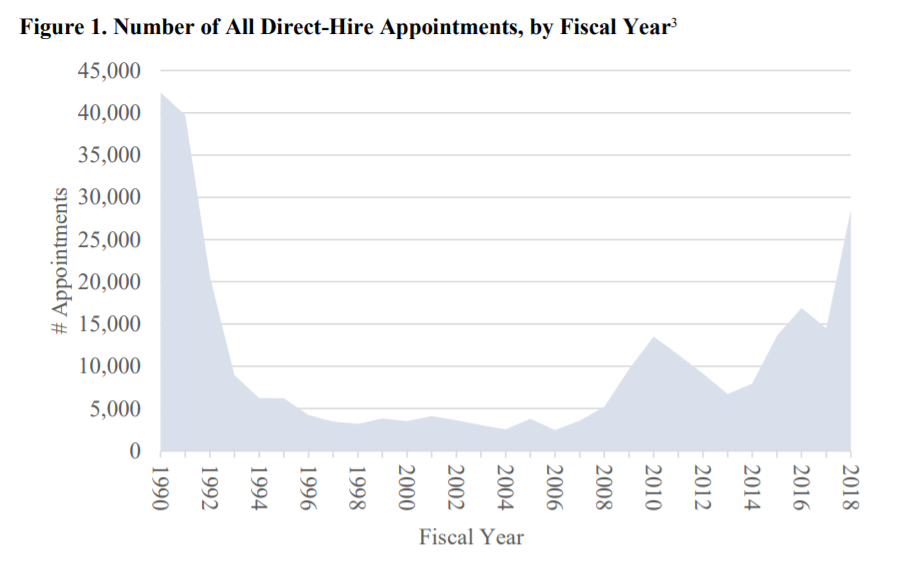
Agencies relying more often on direct hire authorities to compete for talent, MSPB says
Agencies are turning more and more to direct hire authorities instead of the usual competitive hiring procedures to bring on new talent to government, a recent...
Agencies are relying more and more on direct hire authorities instead of the usual competitive hiring procedures to bring new talent into the government.
According to a recent study from the Merit Systems Protection Board, agencies used direct hire authorities to make 28,000 appointments in fiscal 2018.
Use of direct-hire authorities peaked in the early 1990s, when agencies used them to make 40,000 new hires in 1990. The authorities fell out of popularity in the mid-to-late 1990s and early 2000s, but agencies began to use them more frequently in the mid-2000s.
Agencies used direct hire to make 4% of their new hires between fiscal 2003 and 2008.
By 2017, the proportion of direct hire appointments grew from 17% of all new hires to 27% of all new hires in 2018, according to the MSPB.

Agencies used just three broad types of authorities to make 99% of their direct hires between 2014 and 2018. The Defense Department has received a variety of authorities in recent years through annual authorization bills, and they make up 47% of all direct hires across government.
One of the more popular direct hire regulations stems from a 2002 law, which allowed the Office of Personnel Management to grant these authorities to agencies for positions where they saw critical skills gaps and a shortage of qualified candidates. Agencies can use the authority to avoid using the usual competitive hiring procedures, like rating and ranking candidates or applying veterans preference.
Some agencies must seek permission from OPM to use this particular authority. Other agencies like DoD or the Department of Veterans Affairs have more leeway.
Agencies used this authority to hire nurses and other medical professionals, as well as IT and contracting specialists, most often, according to the MSPB.
Data also shows agencies used the direct hire authority to appoint talent to more mid and senior-level jobs, which, according to the MSPB, makes some sense given the types of professional and administrative positions that needed filling.
“The trend also suggests that agencies had an immediate need for highly skilled (and graded) employees to address new, emerging or already understaffed needs,” the MSPB wrote. “In addition, they could have been replacing expertise lost through retirements and other turnover, so they hired employees who could hit the ground running rather than those who would need to be developed.”
On first glance, the MSPB noted the data seems to show agencies hired more women over men using direct hire authorities. But agencies tend to use these authorities to fill certain positions over others, and in many cases, more women tend to take on these jobs, such as nursing, where organizations struggle to find talent under normal competitive hiring procedures.
When it came to recruiting new employees with different racial or ethnic backgrounds, the MSPB also saw relatively few differences in direct hire versus competitive hiring.
“Direct hire authority has at least a comparable, but sometimes improved, effect on agencies’ new hire representation,” the MSPB said.
Agencies, for example, hired substantially more African Americans to contracting positions using direct hire authorities compared to competitive hiring. The MSPB also saw a slight increase in the hiring of African American, Asian and Pacific Islander new hires to IT positions using specialized authorities.
Conversations with agency human resources specialists, OPM and other focus groups demonstrate even greater nuances with direct hire authority, the MSPB said.
Chief human capital officers told the MSPB they didn’t believe direct-hire authorities had much of an impact on their ability to hire a diverse workforce based on merit.
But focus group participants had a different view and perceived direct-hire as a potentially “less fair” option compared to the traditional competitive hiring procedures.
“For instance, a couple of participants commented that it can be used to ‘get around’ veterans’ preference so hiring officials do not need to consider veterans,” the MSPB said. “We note that the DHA statute exempts agencies from applying veterans’ preference, but OPM does instruct agencies that ‘qualified candidates with veterans’ preference should be selected as they are found.’ Therefore, the authority should not be used to avoid hiring candidates with preference.”
And while agencies are only supposed to use the authorities when they face a critical skills gap or shortage of candidates, MSPB said some organizations view direct-hire as a way to find more qualified candidates more broadly.
The data, especially the growing usage of these authorities, shows agencies are searching for ways around the traditional hiring methods.
“This rapid growth is a clear indicator of frustration with the results of current competitive service hiring procedures,” MSPB said. “It also suggests that direct hire authorities may no longer be just an avenue to supplement competitive hiring for occupations in which critical hiring needs or severe shortages of candidates exist. The time is right for thoughtful, well-planned hiring reform that balances the principles of fairness, openness, quality and efficiency.”
Copyright © 2025 Federal News Network. All rights reserved. This website is not intended for users located within the European Economic Area.
Nicole Ogrysko is a reporter for Federal News Network focusing on the federal workforce and federal pay and benefits.
Follow @nogryskoWFED




